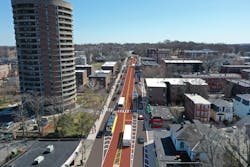City of Boston, MBTA break ground on Columbus Ave Bus Lane Project
The city of Boston and the Massachusetts Bay Transportation Authority (MBTA) have broken ground on a first-of-its-kind transit facility in Metro Boston that aims to improve bus speed and reliability access for riders relying on three routes connecting Mattapan, Dorchester, Roxbury and Jamaica Plain with the Orange Line.
“Creating safe, affordable and equitable transportation options in Boston is a key goal of the Walsh Administration and our Go Boston 2030 plans,” said Boston’s Chief of Streets Chris Osgood. “This bus lane will help improve speed and access for those who rely on these bus routes, and I thank all partners involved for making this possible.”
The center-running bus lane project along Columbus Avenue between Walnut Avenue and Centre Street/Ritchie Street is part of a series of projects that the MBTA and the city of Boston are undertaking to dramatically overhaul bus service.
“Once completed, this will be one of the premier pieces of bus priority infrastructure in our system and a major investment in transit equity,” said MBTA General Manager Steve Poftak. “This is only the first step. Our aim is to work with Boston and our other municipal partners to build a network of high-quality bus priority infrastructure across our service area. These partnerships will transform how commuters travel across the region.”
Since the state-wide public health emergency was declared in March, ridership for Bus Routes 22, 29 and 44, which travel through the project corridor, has been above system-wide averages. These routes also serve some of the highest rates of low-income and minority riders within the MBTA’s system. According to a 2017 CTPS survey, 91 percent of Route 22 bus riders are non-white.
Center-running bus lanes allow for faster, more reliable service by decreasing the likelihood that buses will be delayed by traffic, slowed down by turning cars or stuck behind double-parked vehicles. Elsewhere in Boston, bus lanes have greatly contributed to improved travel times and better service. On Washington Street in Roslindale, transit travel times were reduced by 20 to 25 percent during the worst hour of congestion after a bus lane was implemented.
A major component of the project is the construction of four pairs of bus boarding platforms with enhanced amenities that include shelters, real-time bus arrival information and seating. These platforms will be constructed with higher curb heights that will make boarding conditions more accessible for all passengers. They will also aid pedestrian safety for people crossing Columbus Avenue by shortening crossing distances and installing new curb ramps and crosswalks. In 2019, there were 25 reported crashes along the project corridor and four of those crashes involved pedestrians.
Over the past year and a half, the city of Boston and MBTA have partnered closely with the community to engage the surrounding neighborhood and design the facility. A separate planning effort being led by the Boston Transportation Department will explore options for developing a bike network on surrounding streets.
The project is expected to be completed by spring 2021 at a total cost of about $10 million with costs shared between the city and MBTA. The city of Boston and MBTA have also been working closely with communities along the Warren Street and Blue Hill Avenue corridors to improve transit and active transportation.
